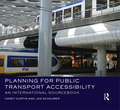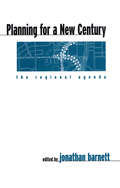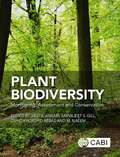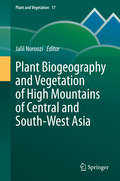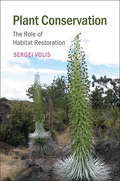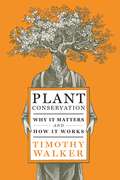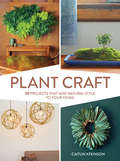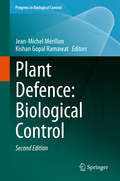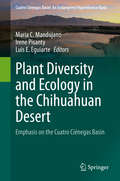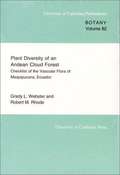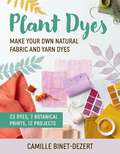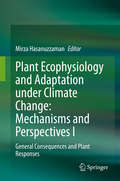- Table View
- List View
Planning for Public Transport Accessibility: An International Sourcebook
by Carey Curtis Jan ScheurerBringing together a comparative analysis of the accessibility by public transport of 23 cities spanning four continents, this book provides a "hands-on" introduction to the evolution, rationale and effectiveness of a new generation of accessibility planning tools that have emerged since the mid-2000s. The Spatial Network Analysis for Multimodal Urban Transport Systems (SNAMUTS) tool is used as a practical example to demonstrate how city planners can find answers as they seek to improve public transport accessibility. Uniquely among the new generation of accessibility tools, SNAMUTS has been designed for multi-city comparisons. A range of indicators are employed in each city including: the effectiveness of the public transport network; the relationship between the transport network and land use activity; who gets access within the city; and how resilient the city will be. The cities selected enable a comparison between cities by old world–new world; public transport modes; governance approach; urban development constraints. The book is arranged along six themes that address the different planning challenges cities confront. Richly illustrated with maps and diagrams, this volume acts as a comprehensive sourcebook of accessibility indicators and a snapshot of current policy making around the world in the realm of strategic planning for land use transport integration and the growth of public transport. It provides a deeper understanding of the complexity, opportunities and challenges of twenty-first-century accessibility planning.
Planning for Resilience: New Paths for Managing Uncertainty (SpringerBriefs in Geography)
by Elena PedeGiven the increasing uncertainty due to catastrophic climate events, terrorist attacks, and economic crises, this book addresses planning for resilience by focusing on sharing knowledge among policy-makers, urban planners, emergency teams and citizens. Chapters look at the nature of contemporary risks, the widespread of resilience thinking and the gap between the theoretical conception and the practices. The book explores how resilience implies a change in planning practices, highlighting the need for flexibility in terms of procedures, and for dynamism in the knowledge systems and learning processes that are the main tools for interaction among different actors and scales. Given its breadth of coverage, the book offers a valuable resource for both academic readers (spatial planners, geographers, social scientists) and practitioners (policymakers, citizens’ associations).
Planning for Rural Resilience: Coping with Climate Change and Energy Futures
by Ralph Martin Chris White Wayne J. Caldwell Erica Ferguson Emanuel Lapierre-Fortin Jennifer Ball Suzanne Reid Paul Kraehling Eric Marr John Devlin Tony Mcquail Margaret Graves Bill Deen Christopher BryantClimate change and an evolving non-renewable energy sector threaten the future viability and sustainability of communities across the country. While rural communities have a special place in the national fabric, they often lack the resources to tackle these important and evolving threats. Planning for Rural Resilience: Coping with Climate Change and Energy Futures makes clear that communities and municipalities have opportunities to make informed and constructive decisions in the face of uncertainty: many of these decisions are “win-win” in the sense that they benefit the community in the short term while also building resilience for the future. Case studies include a town rebuilding itself after a tornado and an individual farmer’s commitment to creating a resilient farm. They provide examples of innovative, successful, and practical on-the-ground actions and strategies. Planning for Rural Resilience asks central questions about the nature of change and the ability to adapt in rural regions. While change is often feared, communities have capacity that can be rallied, harnessed, and turned towards planning policy and action that responds to threats to the future. This important work will assist municipal decision makers, planners, and community members as well as anyone who has a passion for the future and betterment of rural life.
Planning for a New Century: The Regional Agenda
by Jonathan BarnettAcross the United States, issues such as sustainability, smart growth, and livable communities are making headlines. Planning for a New Century brings together leading thinkers in the fields of planning, urban design, education, welfare, and housing to examine those issues and to consider the ways in which public policies have helped create--and can help solve--many of the problems facing our communities. Each chapter identifies issues, provides background, and offers specific policy suggestions for federal, state, and local initiatives. Topics examined include: *the relation of existing growth management policies to social equity, as well as how regional growth management measures can make new development more sustainable *how an obscure technical procedure in highway design becomes a de facto regional plan *ways in which local governments can promote environmental preservation and better-designed communities by rewriting local zoning and subdivision ordinances *why alleviating housing shortages and slum conditions has resulted in a lack of affordable housing, and how that problem can be solved *how business improvement districts can make downtowns cleaner, safer, and more welcoming to workers and visitors In addition, the book features chapters on public safety, education, and welfare reform that include proposals that will help make regional growth management easier as inner-city crime is reduced, schools are improved, and concentrations of extreme poverty are eliminated. Planning for the New Century brings together current academic research with pressing public policy concerns, and will be a useful resource for policymakers at all levels of government, for planners and architects, and for students and scholars of urban planning and design, and urban studies.
Planning for the Planet: Environmental Expertise and the International Union for Conservation of Nature and Natural Resources, 1960–1980 (Environment in History: International Perspectives #16)
by Simone SchleperIn the 1960s and 1970s, rapidly growing environmental awareness and concern not only led to widespread calls for new policies, but also created unprecedented demand for ecological expertise. This led to novel challenges for advocacy groups such as the International Union for the Conservation of Nature, which had to navigate rival scientific approaches, Cold War politics, and decolonization in their efforts to integrate the study and protection of nature into international policymaking. This book reveals how, despite their vast scientific knowledge and attempts to incorporate socially relevant themes, experts inevitably struggled to make conservation a central part of environmental politics within intergovernmental organizations like the United Nations.
Planning for the Planet: Environmental Expertise and the International Union for Conservation of Nature and Natural Resources, 1960–1980 (Environment in History: International Perspectives)
by Simone SchleperDuring the 1960s and 1970s, rapidly growing environmental awareness and concern created unprecedented demand for ecological expertise and novel challenges for ecological advocacy groups such as the International Union for Conservation of Nature and Natural Resources (IUCN). This book reveals how, despite their vast scientific knowledge and their attempts to incorporate socially relevant themes, IUCN experts inevitably struggled to make global schemes for nature conservation a central concern for UNESCO, UNEP and other intergovernmental organizations.
Plant Biodiversity Conservation in Ethiopia: A Shift to Small Conservation Reserves
by Kflay Gebrehiwot YaynemsaThis book covers biodiversity conservation under special consideration of the challenges in the global south with particular attention being paid to consider the existing conservation challenges in relation to the study area in Ethiopia. Key issues are addressed, such as the current and future threats to plant biodiversity in Ethiopia, as well as the single large or several small conservation approaches and which approach is feasible for Ethiopia. Furthermore, an innovative approach was developed that enhances ecological connectivity and promotes ecological restoration through community involvement. The book also covers why a systematic conservation planning approach is important and should be used in new protected area establishments, and also looks at the trends of plant ecology research over the past five decades, revealing research gaps and suggesting future research topics. Despite its focus on Ethiopian plant diversity, abundant examples were used from different continents making this book attractive to global readers. It will be of interest for policy- and decision-makers in the conservation sector, researchers interested in biodiversity, climate change, conservation and sustainable use of natural resources, and would be a valuable resource for university students.
Plant Biodiversity: Monitoring, Assessment and Conservation
by Nishanta Rajakaruna Tarique Hassan Askary Mohammad Mobin Munir Ozturk Sanjeev Kumar Zahid Khorshid Abbas Subrata Trivedi Hasibur Rehman Anand Mohan Volkan Altay Shabir Ahmad Mir Mohammad Maqbool Mir Shalini Saggu Maria Amélia Martins-Loução Gisela Gaio-Oliveira Umar Iqbal Shafat Ahmad Banday Sheikh Mehraj Munib Ur Rehman Ghulam Hasan Rather Sunit Mitra Sobhan Kumar Mukherjee Kathryn E Barry Stefan A Schnitzer Salih Gucel Syed Baker K S Kavitha P. Azmath D Rakshith B P Harini S Satish Asma-Hammami Semmar Nabil Semmar Otília Correia Lia Ascensão Sulaiman Mohammad Al-Ghanim Fahad Mohammed Alzeibar Mudasir Irfan Dar Mohd Irfan Naikoo Fareed Ahmad Khan Farha Rehman Fouzia Nousheen H C Rao Martin T Dokulil Gopal Shukla Nazir A Pala Saikat Gantait Sumit Chakravarty Jyoti K Sharma Saiful Islam S M Sundarapandian K Subashree Pundarikakshudu Tetali Sujata Tetali Sankar K Ghosh Anjula Pandey K Pradheep K S Negi José Antonio González Ana Maria Carvalho Francisco Amich Uma Rani Sinniah Narayan Chandra Sahu Abir Sarraj Meg Trau Robin Owings Petros Ganatsas Disha Jaggi Mayank Varun Saurabh Pagare Niraj Tripathi Meenal Rathore Raghwendra Singh Bhumesh KumarResults of regular monitoring of the species diversity and structure of plant communities is used by conservation biologists to help understand impacts of perturbations caused by humans and other environmental factors on ecosystems worldwide. Changes in plant communities can, for example, be a reflection of increased levels of pollution, a response to long-term climate change, or the result of shifts in land-use practices by the human population. This book presents a series of essays on the application of plant biodiversity monitoring and assessment to help prevent species extinction, ecosystem collapse, and solve problems in biodiversity conservation. It has been written by a large international team of researchers and uses case studies and examples from all over the world, and from a broad range of terrestrial and aquatic ecosystems. The book is aimed at any graduate students and researchers with a strong interest in plant biodiversity monitoring and assessment, plant community ecology, biodiversity conservation, and the environmental impacts of human activities on ecosystems.
Plant Biogeography and Vegetation of High Mountains of Central and South-West Asia (Plant and Vegetation #17)
by Jalil NorooziThis book presents an overview study about plant biogeography and vegetation of the high mountains of Central and South-West Asia, by a group of specialists familiar with its area and plant growth and ecology. This book discusses its ecological and evolutionary drivers and also its conservation priorities.Central and South-West Asia is one of the most diverse areas in the northern hemisphere and several biodiversity hotspots are concentrated in this region. Most of the biodiversity hotspots are associated with high mountain ranges of the region. Moreover, these mountains have been immigration corridors for the Central Asian flora to reach Euro-Siberian and Mediterranean regions. Despite its importance, there is no overview publication to present the plant biogeography and vegetation of these mountains and most of the publications are local or rather imprecise
Plant Biomechanics: From Structure to Function at Multiple Scales
by Joseph Gril Anja GeitmannThis book provides important insights into the operating principles of plants by highlighting the relationship between structure and function. It describes the quantitative determination of structural and mechanical parameters, such as the material properties of a tissue, in correlation with specific features, such as the ability of the tissue to conduct water or withstand bending forces, which will allow advanced analysis in plant biomechanics. This knowledge enables researchers to understand the developmental changes that occur in plant organs over their life span and under the influence of environmental factors. The authors provide an overview of the state of the art of plant structure and function and how they relate to the mechanical behavior of the organism, such as the ability of plants to grow against the gravity vector or to withstand the forces of wind. They also show the sophisticated strategies employed by plants to effect organ movement and morphogenesis in the absence of muscles or cellular migration. As such, this book not only appeals to scientists currently working in plant sciences and biophysics, but also inspires future generations to pursue their own research in this area.
Plant Collectors in Angola: Botany, Exploration, and History in South-Tropical Africa (Regnum Vegetabile)
by Estrela Figueiredo Gideon F. SmithAn authoritative treatise on the history of botanical studies and exploration in Angola. For any region, cataloging, interpreting, and understanding the history of botanical exploration and plant collecting, and the preserved specimens that were amassed as a result, are critically important for research and conservation. In this book, published in cooperation with the International Association for Plant Taxonomy, Estrela Figueiredo and Gideon F. Smith, both botanists with expertise in the taxonomy of African plants, provide the first comprehensive, contextualized account of plant collecting in Angola, a large country in south-tropical Africa. An essential book for anyone concerned with the biodiversity and history of Africa, this authoritative work offers insights into the lives, times, and endeavors of 358 collectors. In addition, the authors present analyses of the records that accompanied the collectors’ preserved specimens. Illustrated in color throughout, the book fills a large gap in the current knowledge of the botanical and exploration history of Africa.
Plant Conservation: An Ecosystem Approach (People And Plants International Conservation Ser.)
by Alan HamiltonIn this, the latest in the People and Plants series, plant conservation is described in the context of livelihoods and development, and ways of balancing the conservation of plant diversity with the use of plants and the environment for human benefit are discussed. A central contention in this book is that local people must be involved if conservation is to be successful. Also examined are ways of prioritizing plants and places for conservation initiatives, approaches to in situ and ex situ conservation, and how to approach problems of unsustainable harvesting of wild plants. Roles for botanists, foresters, sociologists, development workers and others are discussed. This book acts as a unifying text for the series, integrating case studies and methodologies considered in previous volumes and pointing out in a comprehensive, accessible volume the valuable lessons to be learned.
Plant Conservation: The Role of Habitat Restoration
by Sergei VolisThe rate of species and natural habitat loss across our planet is steadily accelerating. This book argues that existing practises of plant conservation are inadequate and firmly supports the placement of ecological restoration at the cornerstone of biodiversity conservation. The author unifies different aspects of conservation into one coherent concept, including natural area protection, ex situ conservation and in situ interventions through either population management or ecological restoration. Assisted colonization, experimentation, and utilization of threatened plant species are raised as crucial elements in restoration, with partly novel ecosystems being among its major target areas. Covering a wide spectrum of plant conservation examples, and offering practical methodologies alongside the theoretical context, this is a vital resource for students, research scientists and practitioners in conservation biology and restoration ecology.
Plant Conservation: Why It Matters and How It Works
by Timothy WalkerPlants’ ability to turn sunlight into energy makes them the basis for all life; without them there is no life. And they are more than just a food source—they provide us with fuel, fibers, and pharmaceuticals. Global warming and the destruction of natural habitats are a serious threat to many plants, and there are worldwide efforts to mitigate the disaster. Plant Conservation tackles this essential topic head on. Timothy Walker, as the director of the Oxford Botanical Garden, a leader in the field of plant conservation, plays a key role in this effort. He highlights what is happening now, from cataloging the world’s flora to conservation efforts like protecting plants from overcollecting. He also shows home gardeners how they can become involved, whether by growing their own food to decrease reliance on large agriculture or by making smart plant choices by growing natives and avoiding invasives. Plant Conservation treats a critical topic in an accessible and optimistic way. It is required reading for students, professionals, and anyone with a keen interest in the importance of plants.
Plant Craft: 30 Projects that Add Natural Style to Your Home
by Caitlin AtkinsonDiscover the simple beauty of adding natural style to a space! Not everyone has a garden—but with only a handful of materials and a little bit of time, everyone can bring the beauty of nature into their home. Plant Craft features projects inspired by the natural world and made out of live plants, cut flowers, foraged branches, and more. You’ll learn how to create a colorful floral mural, an elegant table centerpiece, a serene underwater sculpture, a whimsical mobile, and more. The step-by-step instructions are clear, easy to follow, and fully illustrated with color photographs, and the projects vary in difficulty. Given the right care, they all have the potential to grace a home for a long time.
Plant Defence: Biological Control (Progress in Biological Control #22)
by Kishan Gopal Ramawat Jean-Michel MérillonInsects, pests and weeds are responsible for substantial loss of crops and reduced food supplies, poorer quality of agricultural products, economic hardship for growers and processor. Generally, chemical control methods are neither always economical nor are they effective and may have associated unwanted health, safety and environmental risks. Biological control involves use of beneficial biological agents to control pests and offers an environmental friendly approach to the effective management of plant diseases and weeds. The chapters are written by well recognized group leaders in the field. This book provides a comprehensive account of interaction of host and pests, and development of biological control agents for practical applications in crops management utilizing inherent defence mechanism, induced stimulation and biological control agents. The contents are divided into the following sections: General biology of plant defence, Use of natural compounds for biological control, Use of biological agents, Mechanism of action and Commercial aspects. The book will be useful for academicians, researcher and industries involved in study and manufacturing these products.
Plant Diversity and Ecology in the Chihuahuan Desert: Emphasis on the Cuatro Ciénegas Basin (Cuatro Ciénegas Basin: An Endangered Hyperdiverse Oasis)
by Luis E. Eguiarte Maria C. Mandujano Irene PisantyEnvironmental and specific diversity in the Chihuahuan desert in general, and in the Cuatro Ciénegas Basin in particular, has long been recognized as outstanding. This book provides a global ecological overview, together with in-depth studies of specific processes. The Chihuahuan desert is the warmest in North America, and has a complex geologic, climatic and biogeographical history, which affects today’s distribution of vegetation and plants and generates complex phylogeographic patterns. The high number of endemic species reflects this complex set of traits. The modern distribution of environments, including aquatic and subaquatic systems, riparian environments, gypsum dunes and gypsum-rich soils, low levels of phosphorous and organic matter, and high salinity combined with an extreme climate call for a range of adaptations. Plants are distributed in a patchy pattern based on punctual variations, and many of them respond to different resources and conditions with considerable morphological plasticity. In terms of physiological, morphological and ecological variability, cacti were identified as the most important group in specific environments like bajadas, characterized by high diversity values, while gypsophytes and gypsovagues of different phylogenies, including species with restricted distribution and endemics.
Plant Diversity of an Andean Cloud Forest: Inventory of the Vascular Flora of Maquipucuna, Ecuador
by Grady L. Webster Robert M. RhodeBased on work spanning a decade, this study of the Maquipucuna area on the western slopes of the Andes discusses the climate, vegetation, ecological relationships, and flora, and emphasizes the importance of the Maquipucuna area as a biological reserve. In addition to the checklist of the flora, which enumerates 1,650 species (including 228 species of pteridophytes and over 200 species of orchids), appendices give information on floristic composition of communities, distribution of epiphytes, and elevational ranges of families and genera. The illustrations include a map, landscapes, and characteristic species.
Plant Dreaming Deep: A Journal
by May SartonThe author&’s tribute to the 18th-century New England farmhouse she called home: &“[A] tender and often poignant book by a woman of many insights&” (The New York Times Book Review). In Plant Dreaming Deep, Sarton shares an intensely personal account of transforming a house into a home. She begins with an introduction to the enchanting village of Nelson, where she first meets her house. Sarton finds she must &“dream the house alive&” inside herself before taking the major step of signing the deed. She paints the walls white in order to catch the light and searches for the precise shade of yellow for the kitchen floor. She discovers peace and beauty in solitude, whether she is toiling in the garden or writing at her desk. This is a loving, beautifully crafted memoir illuminated by themes of friendship, love, nature, and the struggles of the creative life. This ebook features an extended biography of May Sarton.
Plant Dreaming Deep: A Journal
by May SartonThe author&’s tribute to the 18th-century New England farmhouse she called home: &“[A] tender and often poignant book by a woman of many insights&” (The New York Times Book Review). In Plant Dreaming Deep, Sarton shares an intensely personal account of transforming a house into a home. She begins with an introduction to the enchanting village of Nelson, where she first meets her house. Sarton finds she must &“dream the house alive&” inside herself before taking the major step of signing the deed. She paints the walls white in order to catch the light and searches for the precise shade of yellow for the kitchen floor. She discovers peace and beauty in solitude, whether she is toiling in the garden or writing at her desk. This is a loving, beautifully crafted memoir illuminated by themes of friendship, love, nature, and the struggles of the creative life. This ebook features an extended biography of May Sarton.
Plant Dyes: Make Your Own Natural Fabric and Yarn Dyes
by Camille Binet-DezertDive into the colorful world of plant-based dyeing!Are you interested in dyeing fabric with plant-based dyes but don't know where to start? Are you a beginner, or would you like to improve your skills and learn more about plant dyeing and printing techniques? This book offers you a complete approach: from picking plants to dyeing fabrics, from mordanting to creating patterns. Besides creating the dyes, learn shibori techniques, how to make flower and leaf prints, tips for dying yarn, and more. You'll also find step-by-step instructions for 12 unique projects including giving new life to a stained shirt, dying cloth napkins, botanical wall hangings, dyed macrame plant hangers, and more. Camille Binet-Dezert's takes an eco-responsible approach, repurposing old fabrics, reusing vegetable peels, and utilizing nature's gifts to their fullest. Color charts show more than 20 common plants that you will give you a beautiful range of dyes.
Plant Ecology and Conservation
by Andrew LackPlant Ecology & Conservation is an introduction to the world of plant ecology. It includes the main areas of current research including ideas about plant populations, nutrition and plant community ecology and has a particular emphasis on the interactions of plants with animals, fungi and microorganisms whose important is being increasingly demonstrated. With the world’s environmental problems having such a high profile, the book focusses on the human impact on the world’s plant species. Conservation of the terrestrial world starts with plants as they form the basis of all ecosystems on land. We can only understand how best to conserve the world’s biodiversity with an understanding of the central role of plant ecology. This theme runs throughout with numerous examples of the disruption of ecosystems by human activity emphasising the connection between plant ecology and conservation. Key Features: Boxes present case studies, important statistics and interesting asides Full-colour photos depict key species and habitats and superb line drawings illustrate many concepts Important data are presented in Tables and Figures throughout Each chapter has Key Concepts and review questions to test a reader’s grasp of the content Key References and Further Reading are given for each chapter to point the reader towards the most important and influential literature Jargon is kept to a minimum and a full Glossary of all technical terms is presented The book is aimed primarily at undergraduate and graduate students in any aspect of ecology or plant science. It should also appeal to anyone interested in how plants function and are concerned about what is needed for the conservation of the world’s ecosystems.
Plant Ecology in a Changing World
by Russell K. Monson James R. EhleringerToday global changes and human activities affect plants within each of the world’s ecosystems. Plant Ecology in a Changing World provides a foundation for understanding how the changes underway impact structure and function in the world’s major biomes, while also describing how evolution has resulted in the biochemical, physiological, structural, and life history features that shaped plants and their capacities to persist across widely contrasting environments. This textbook is designed for undergraduate students and graduate students as well to serve as a resource for climate change and ecosystem scientists seeking a foundation on the principles of plant ecology and the basis of plant adaptations. While many textbooks focus primarily on natural ecosystems, Plant Ecology in a Changing World also recognizes the ecological importance of invasive, managed, and urban ecosystems and of the ways in which ecosystems are already being impacted by both human activities and a warming planet.Key features: Replete with 450+ figures that help to elucidate concepts and charts to clearly present key data Boxes within chapters allow those who wish to delve into more advanced aspects of topics and of those key methodological approaches used to quantify processes Highlights of key plant ecologists and of their contributions Each chapter concludes with a bulleted summary, enabling students to recap the key points of the chapter Each chapter comes with both a list of references, as well as with suggested readings, allowing the student to expand their knowledge on a particular topic Associated with the book is an array of supplementary materials. These are available and constantly updated at http://plantecology.site.
Plant Ecophysiology and Adaptation under Climate Change: General Consequences and Plant Responses
by Mirza HasanuzzamanThis book presents the state-of-the-art in plant ecophysiology. With a particular focus on adaptation to a changing environment, it discusses ecophysiology and adaptive mechanisms of plants under climate change. Over the centuries, the incidence of various abiotic stresses such as salinity, drought, extreme temperatures, atmospheric pollution, metal toxicity due to climate change have regularly affected plants and, and some estimates suggest that environmental stresses may reduce the crop yield by up to 70%. This in turn adversely affects the food security. As sessile organisms, plants are frequently exposed to various environmental adversities. As such, both plant physiology and plant ecophysiology begin with the study of responses to the environment. Provides essential insights, this book can be used for courses such as Plant Physiology, Environmental Science, Crop Production and Agricultural Botany.Volume 1 provides up-to-date information on the impact of climate change on plants, the general consequences and plant responses to various environmental stresses.
